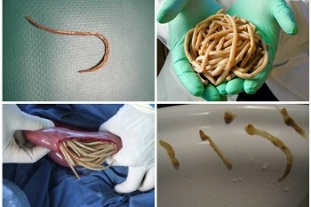There is a risk of getting infected with worms without leaving your home. Different types of helminths are found in household items, banknotes, dishes, food and drinking water.
Parasites enter the human body in a way that suits them: they can enter the digestive system through food, water, dirty hands or insect bites.
In addition, helminths affect certain internal organs, use the resources of the human body, cause mechanical damage and actively reproduce. Their vital processes are accompanied by unpleasant and often dangerous symptoms and damage to various organs.
How to recognize intestinal worms

Intestinal helminthiasis is a group of diseases caused by different types of worms. In most cases, ascariasis (roundworm), enterobiasis (pinworms), hookworm disease (hookworm) can be detected. These parasites live in the lumen of the human intestine, feed on the substances they contain, and their presence can be suspected by a number of characteristic symptoms:
- Acute weight loss without changes in diet and physical activity. Intestinal helminths use nutrients in the human body as a source of energy for growth and reproduction, and damage the walls of intestinal fixation devices (absorbers, hooks) and prevent the absorption of remaining trace elements.
- Pain in the stomach, navel, itching in the rectum, movement of worms, mechanical injuries they cause, as well as the expulsion of larvae or adults from the body.
- Various digestive disorders: diarrhea or constipation, flatulence, mucus in the stool, foam or blood, nausea, vomiting. In some cases, adult parasites are found in the stool.
- The human body can react to the formation of parasites with allergic reactions, intoxication, caused by helminthic waste. More often it is manifested by itching of the skin, redness of certain areas, rashes (vesicles, blisters of various sizes).
Signs of parasites in the liver
The human liver stores large amounts of nutrients, and there is a tight blood circulation, which is good for parasites. General hepatic helminthiasis: fascioliasis, opisthorchiasis, dichroseliosis caused by worms of the group of liver flukes.
You can identify them by their specific features:

- Acute pain in the right hypochondrium is caused by the mechanical action of helminths. Thus, echinococcus forms cysts in the tissues of the body, causing the development of inflammatory processes or even necrosis.
- Adult worms (roundworms) can block the bile ducts, so bile flow is impaired, digestion becomes difficult in the body, and the patient develops symptoms of jaundice. The visible mucous membrane of a person turns yellow and the skin is stained with the development of pathology.
- Non-specific symptoms of the appearance of parasites will be worsening of the general condition of the body, weight loss, nausea, lethargy.
Blood is given for analysis to confirm the diagnosis. Leukocytosis, eosinophilia are detected, and biochemical tests will show an increase in the activity of liver enzymes (ALT, AST). Liver damage can be seen on ultrasound: growth, inflammation and, in some cases, parasitic cysts.
What indicates the presence of pulmonary helminths
Some parasites (ascaris, toxoplasma, echinococcus, tsenur) can pass from the gastrointestinal tract into the lungs of a person with blood or lymph flow. They multiply in the alveoli, making it difficult to breathe, and some species (echinococcus unicameral) form cysts that damage organ structure.Because the symptoms are similar to those of respiratory diseases of viral and non-infectious etiology (bronchitis, ARVI), it can be difficult to determine the presence of parasites in the lungs. Cough, shortness of breath, chest pain, fever indicate the need for additional examination of the patient's body.
X-ray method for the diagnosis of pulmonary helminthiasis will be the most informative. The images will show lesions in the human body caused by echinococci (cysts) and bovine tapeworm (fibrous formations), which must then be distinguished from neoplasms, cysts of various etiologies and pneumonia.
Blood parasites

Protozoa single-celled worms can be found in the lumen of blood vessels. Babesias, plasmodia (malaria plasmodium), trypanosomes, microfilaria, schistosomes cause dangerous diseases that threaten human life.
By destroying the shaped elements, they disrupt the body's energy metabolism and impede the supply of nutrients to organs and tissues.
In most cases, human infections occur after an insect or tick bite. After a while, the body develops symptoms of anemia: paleness, followed by cyanosis of the mucous membranes, dizziness, sudden weight loss and poor health. Without timely medical care, blood parasites can pose a serious threat to human life.
Diagnosis involves microscopic examination of the blood, during which you can find single-celled parasites and destroyed erythrocytes, as well as identify the type of worm. Treatment is long, inpatient under the supervision of a qualified physician.
Unusual Parasitic Habitats
Some helminth species can penetrate the human heart, subcutaneous tissue (dirofilariae), brain and spinal cord (cysticercus, echinococcus). Not only in exotic countries, but also by eating familiar food that is not subjected to the necessary heat treatment, it is possible to become infected, and pets can be carriers. Signs of occupation depend on the degree of damage to a particular organ.
In the brain, worms can form cysts, fibrous formations that cause nerve events.

Headaches of unknown etiology, tremors (vibrations) of the extremities, changes in tactile sensitivity, impaired coordination of movements, severe deterioration of hearing and vision - signs of development of the occupation depend on the location of worms and their larvae.
Adult parasites can be seen under the skin, usually in the eyes, ear canals, and other areas with itching and tingling sensations.
What to do if you see signs of wolf invasion
Diseases of parasitic etiology are treated under the supervision of a physician after all the necessary examinations and establishment of the type of parasite. Prescribe anthelmintic drugs with a narrow or broad spectrum of action, conduct restorative and symptomatic therapy, encourage the removal of worms from the body. In some cases, surgery is indicated.
When treatment is started on time, the prognosis of most diseases is favorable. If you delay a visit to a doctor or start taking medication yourself, the healing process can be slowed down and many types of parasites can damage vital organs and body systems and even cause death.



























